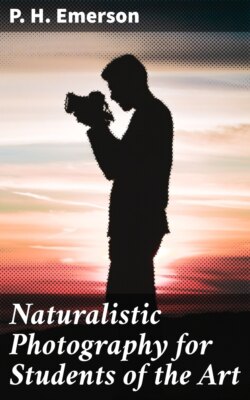Читать книгу Naturalistic Photography for Students of the Art - P. H. Emerson - Страница 12
На сайте Литреса книга снята с продажи.
Egyptian Art.
ОглавлениеEgyptian art.
On examining specimens of Egyptian art, whether it be their paintings, architecture, sculpture or book illustrations (the papyri), one is struck by the wonderful simplicity, decision and force with which they expressed themselves. The history of Egypt has been so little studied, save by students of history, and the old popular stories concerning the nations of the past are so inaccurate and misleading, that one is at first surprised to find such power in the works of those whom we were taught, not so long ago, to look upon as Philistines; so that we might gaze on the Pyramids of Gizeh, the statues of Rameses, and the granite lions, with the wonderment of incomprehension. But now, of course, every one knows that the Egyptians were masters in certain directions, where we are but in our infancy. Even in their cavi relievi and wall paintings, though these latter are but tinted outlines, they are not the outlines of childish draughtsmen, weak and unmeaning, but they show the force of a powerful skill that in one bold outline can give all the essentials of a man, bird or beast, so that the picture looks living and doing. All through their work there is a bigness of conception, a solid grip of nature which makes their work surpass many of the elaborately finished and richly detailed pictures of our modern art galleries.
Works to be studied.
Let us call the reader’s attention to such examples as are easily to be seen, namely, |The lions.|the granite lions, the cavi relievi and the papyri in the British Museum. The lions, which are remarkable for strength of character and truthfulness of impression, may be taken as representative of the greatest period of Egyptian art, a period which ended about the time of Rameses II.; for after that time the artist began to neglect the study of nature, and gradual decadence set in.
Landseer’s lions.
We strongly advise all our readers to go to the British Museum and look well at these lions. They are hewn from granite, or porphyry, the hardest of stones, they have conventional moustaches, and are lying in conventional positions, yet withal, there is a wonderful expression of life and reserved strength about them which makes you respect them, stone though they be; and they convey to you, as you look on their long lithe flanks so broadly and simply treated, the truthful impression of strong and merciless animals. Your thoughts involuntarily turn from them to Landseer’s bronze lions guarding Trafalgar Square. In them you remember all the tufts of hair correctly rendered, even to the wool in the ears, the mane, the moustaches. Even the claws are there, and yet you feel instinctively you would rather meet those[2] tame cats of Trafalgar Square, with all their claws, than the Egyptian lions in the British Museum. The reason of this is that the Egyptians knew how to epitomize, so as to express the fundamental characteristics of the lion, they cared not to say how many hairs went to make up the tufted tail, nor yet how many claws each paw should have, but what they tried to do, and succeeded in doing, was to convey a sense of his power and animalism, or to convey, in short, an impression of his nature.
2. Since this was written Mr. Frith has published that Landseer modelled these lions from a tame cat.
These lions were the outcome of the best period of Egyptian sculpture. The Egyptian artists who carved those lions had been striving to interpret Nature, and hence their great success; but as soon as their successors began to neglect nature, and took to drawing up rules, they went wrong, and produced caricatures. |Rameses II. and decadence.| We read that after the time of Rameses II. “every figure is now mathematically designed according to a prescribed canon of numerical proportions between the parts.”
Wilkinson’s “Ancient Egyptians.”
All this we can trace for ourselves in the plates supplied with Wilkinson’s learned work, entitled, “The Ancient Egyptians.” We see in those plates that something has happened to the people and objects represented, something that makes them no longer tell their own story, they no longer look alive, but are meaningless; the reason of this falling off was that the artist no longer used his eyes to any purpose, but did what was then supposed to be the right thing to do, namely, followed the laws laid down by some men of narrow intellect—laws called as now the “canons of art.” The very life of the Egyptian artists of that period was against good work, for they were incorporated into guilds, and the laws of caste worked as harmfully as they now do in the Orient. |Artists'
status.| There is, then, distinct evidence that on the one hand the Egyptian artists of the best period, when untrammelled by conventionality, created works which, though lacking the innumerable qualities of later Greek art, yet possessed, so far as they went, the first essential of all art—truth of impression. Again, on the other hand, directly anything like “rules of art” appeared, and the study of nature was neglected, their art degenerated into meaningless conventionality, and as this conventionality and neglect of nature were never cast aside, the art of Egypt never developed beyond the work done by the artists who carved the stone lions.
